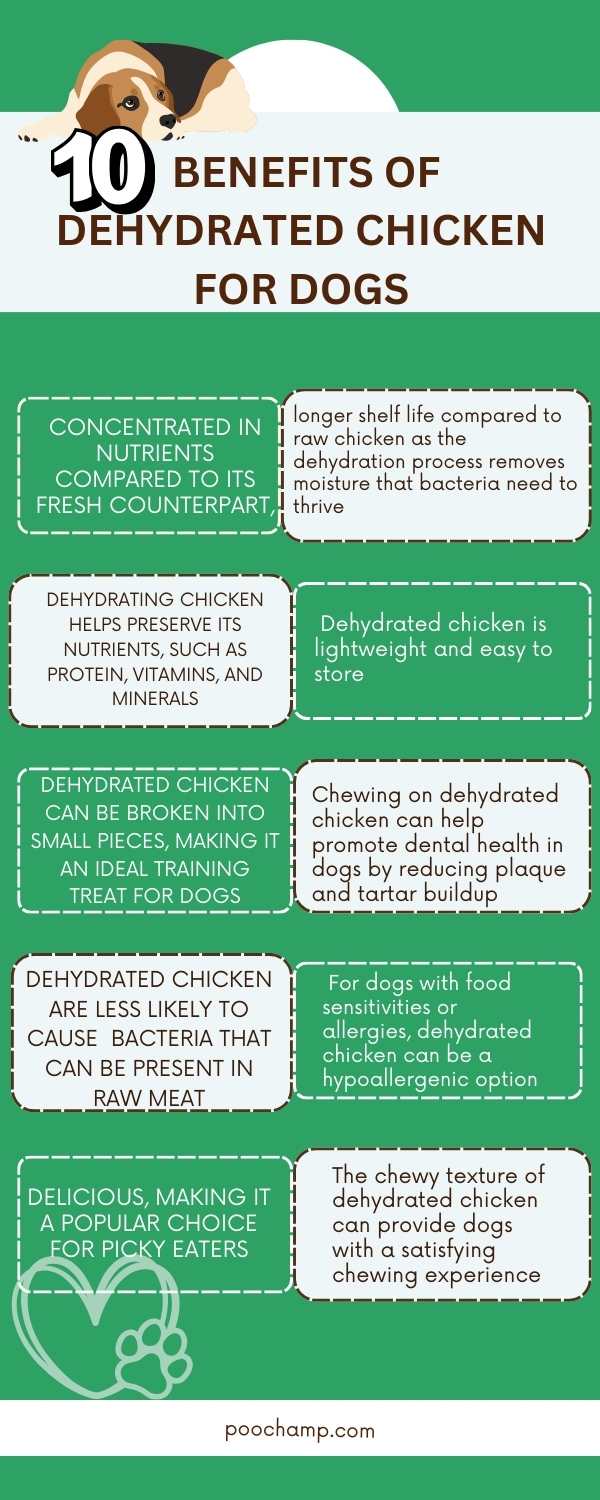Dehydrated chicken is a delicious and convenient treat for dogs that can be easily made at home. This method of preparation involves cooking the chicken at a low temperature for an extended period of time, which removes moisture from the meat and intensifies its flavor. Not only is dehydrated chicken a tasty snack for your furry friend, but it also has several benefits for their health.
Can dogs eat dehydrated chicken?
Yes, dogs can eat dehydrated chicken as an occasional treat. However, it should not make up a significant portion of their diet as it may be high in salt and other preservatives. It’s best to offer small amounts of dehydrated chicken as a special snack rather than a regular meal for your dog. Additionally, be sure to monitor your dog for any signs of digestive upset or allergies after eating dehydrated chicken.
Benefits of dehydrated chicken for dogs.
Dehydrated chicken can offer several benefits for dogs:
1- Nutrient retention: Dehydrating chicken helps preserve its nutrients, such as protein, vitamins, and minerals, which are essential for a dog’s overall health and well-being.
2- Improved digestibility: Dehydrated chicken is more concentrated in nutrients compared to its fresh counterpart, making it easier for dogs to digest. This can be beneficial for dogs with sensitive stomachs or digestive issues.
3- Longer shelf life: Dehydrated chicken has a longer shelf life compared to raw chicken, as the dehydration process removes moisture that bacteria need to thrive. This can be convenient for pet owners looking to stock up on healthy treats for their dogs.
4- Convenience: Dehydrated chicken is lightweight and easy to store, making it a convenient option for pet owners on-the-go or those looking for a mess-free treat for their furry friends.
5- Training aid: Dehydrated chicken can be broken into small pieces, making it an ideal training treat for dogs. Its intense flavor can also serve as a motivating reward during training sessions.
6- Dental health: Chewing on dehydrated chicken can help promote dental health in dogs by reducing plaque and tartar buildup, which can contribute to better oral hygiene.
7- Safety: Dehydrated chicken treats are less likely to cause harmful bacteria that can be present in raw meat, reducing the risk of food-borne illnesses in dogs.
8- Allergy-friendly: For dogs with food sensitivities or allergies, dehydrated chicken can be a hypoallergenic option, as it typically contains fewer additives and fillers than some commercial dog treats.
9- Texture: The chewy texture of dehydrated chicken can provide dogs with a satisfying chewing experience, which can help alleviate boredom and support dental health.
10- High palatability: Most dogs find dehydrated chicken delicious, making it a popular choice for picky eaters.

How to make dehydrated chicken for dogs at home.
There are a few different methods you can use to dehydrate chicken for your dog:
Oven
Preheat your oven to the lowest setting (usually around 170-200°F). Slice your chicken into thin strips or cubes and place them on a baking sheet lined with parchment paper. Bake for several hours, checking periodically to see if the chicken is dried out to your desired consistency.
Dehydrator
Step 1: Slice the chicken into thin strips or cubes.
Step 2: Arrange the chicken pieces on the trays of the dehydrator, making sure to leave space between each piece for proper air circulation.
Step 3: Place the trays in the dehydrator and set the temperature according to the manufacturer’s instructions. Typically, you will want to set the dehydrator to around 140-160°F for meat.
Step 4: Allow the chicken to dehydrate for several hours, checking periodically to see if it is drying out to your desired consistency.
Step 5: Once the chicken is fully dehydrated, remove it from the dehydrator and allow it to cool before storing it in an airtight container in the refrigerator or freezer.
Air drying
If you don’t have an oven or dehydrator, you can air dry the chicken by hanging it in a well-ventilated area. Make sure the chicken is thinly sliced and hang it in a place where it won’t be disturbed. It may take a few days for the chicken to fully dry out.
Once the chicken is fully dehydrated, store it in an airtight container in the refrigerator or freezer to keep it fresh. Remember to only give your dog small amounts of dehydrated chicken as an occasional treat.
Step-by-Step Guide for Dehydrated Chicken Jerky for Dog Treats
- Cut large chicken pieces into thin strips or bite-sized pieces that dehydrate quicker, as thicker slices might take more time to dehydrate evenly. It is essential to have uniform thickness between all pieces for even drying results.
- Preheat your food dehydrator or oven to a lower temperature, around 70 degrees, to slowly evaporate moisture from the chicken without creating heat damage or cooking it further.
- If you already add seasonings to your dog’s food, now is an excellent opportunity to add them to the chicken. Sprinkle or rub on any desired seasonings over its surface.
- Place chicken strips on a dehydrator tray or oven and make sure they don’t touch. This ensures proper air circulation for drying purposes and ensures even thickness throughout.
- Once the tray has been prepared, place it into your oven or dehydrator and open its door slightly to allow moisture to escape as drying proceeds.
- Dehydration should take between 4 and 12 hours. To ensure an even drying process, monitor its progress closely and stop dehydrating when the desired levels of dryness have been reached. Rotate trays as necessary to ensure even drying conditions.
- Chicken strips should be cooked when they become leathery in texture without any moisture present and easily break when bent. Once dehydrated, remove them from the tray and allow them to cool before placing them back onto it for storage.
How should dehydrated treats be stored
To ensure the freshness and quality of dehydrated treats for dogs, here are some tips on how to store them properly:
Cool, dry place: Store dehydrated treats in a cool, dry place away from direct sunlight and heat sources. Exposure to heat and light can degrade the quality of the treats and shorten their shelf life.
Airtight container: Transfer the dehydrated treats to an airtight container or resealable bags to prevent moisture from getting in. Moisture can cause the treats to become soft or moldy, reducing their quality.
Labeling: Label the container or bag with the date of when the treats were made or purchased. This can help you keep track of their freshness and ensure you use them within a reasonable timeframe.
Refrigeration: While most dehydrated treats are shelf-stable, refrigeration can further extend their shelf life, especially in hot and humid environments. Make sure the treats are completely cool before storing them in the refrigerator.
Freezing: If you have a large batch of dehydrated treats or want to store them for an extended period, consider freezing them. Place the treats in a freezer-safe container or bag, removing as much air as possible to prevent freezer burn.
Rotate stock: If you make or purchase dehydrated treats in bulk, consider rotating your stock to use the oldest treats first. This will help prevent treats from sitting around for too long and losing their freshness.
Check for signs of spoilage: Periodically inspect the dehydrated treats for any signs of spoilage, such as mold, off smells, or changes in color or texture. Discard any treats that show signs of spoilage.
By following these storage tips, you can help maintain the freshness and quality of dehydrated treats for your furry friend to enjoy.
Why is dehydrated chicken for dogs different from other preparation method?
Dehydrated chicken is different from other chicken preparation methods for dogs in a few key ways:
Dehydrated chicken is cooked at a low temperature for an extended period of time, which removes moisture from the meat and concentrates the flavors. This can make dehydrated chicken more flavorful and chewy compared to other cooking methods like boiling, baking, or grilling.
Dehydrated chicken for dogs has a longer shelf life than fresh or cooked chicken. Since the moisture has been removed, dehydrated chicken can be stored in an airtight container for longer periods of time without spoiling.
Dehydrated chicken is typically easier to break into smaller pieces or strips, making it a convenient and portable treat for dogs. It can also be a good option for dogs with sensitive stomachs or digestive issues, as the dehydration process can make the chicken easier to digest.
Overall, dehydrated chicken for dogs can be a tasty and healthy treat when offered in moderation, but it’s important to consider the potential higher salt and preservative content compared to other cooking methods.
What are some other popular types of dehydrated treats for dogs?
Some other popular types of dehydrated treats for dogs include:
Sweet potato: Dehydrated sweet potato slices are a tasty and nutritious alternative to traditional dog treats. They are rich in fiber, vitamins, and minerals, making them a healthy snack option for dogs.
Liver: Dehydrated liver treats, such as beef or chicken liver, are often a favorite among dogs due to their strong flavor. They are rich in protein and essential nutrients, making them a good choice for training or occasional rewards.
Fish: Dehydrated fish treats, like salmon or whitefish, are loaded with omega-3 fatty acids, which promote healthy skin and coat in dogs. They are often a great option for dogs with food sensitivities or allergies.
Vegetables: Dehydrated vegetables, such as carrots, green beans, or peas, can be a crunchy and low-calorie treat for dogs. They provide vitamins, minerals, and antioxidants, making them a healthy snack option.
Organ meat: Dehydrated organ meats, like hearts or kidneys, are nutrient-dense treats that offer a variety of essential vitamins and minerals, including iron and B vitamins. They can be a flavorful and beneficial addition to a dog’s diet.
Apples: Dehydrated apple slices are a sweet and crunchy treat that many dogs enjoy. Apples are rich in fiber and antioxidants, making them a healthy snack choice for dogs in moderation.
Turkey: Dehydrated turkey treats are another protein-rich option for dogs. They are often leaner than some other meat treats, making them a good choice for dogs on a restricted diet.
Pumpkin: Dehydrated pumpkin can be a delicious and digestible treat for dogs. Pumpkin is high in fiber and beta-carotene, which can support digestive health and immune function in dogs.
Yogurt: Dehydrated yogurt treats can provide probiotics that support gut health in dogs. They can be a creamy and nutritious reward for dogs, especially those with sensitive stomachs.
Coconut: Dehydrated coconut flakes can offer dogs a sweet and tropical treat. Coconut is a good source of healthy fats and can support skin and coat health in dogs.
Dehydrated chicken is a great way to provide your dog with a healthy and flavorful treat. Whether you use an oven, dehydrator, or air-drying method, preparing dehydrated chicken at home is simple and cost-effective. This method of cooking results in a chewy and delicious snack that can be stored for longer periods of time. Not only is dehydrated chicken a convenient option for pet owners, but it also offers benefits for dogs, such as being easier to digest and a good option for dogs with sensitive stomachs. Remember to offer dehydrated chicken in moderation as an occasional treat to keep your pup happy and healthy.







